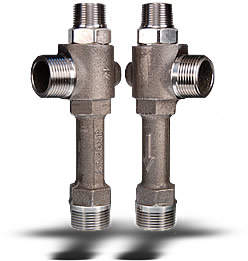 Net Positive Suction Head (NPSH)
is one of the most used terms for pumps (including eductors)
and also one of the least understood. Simply stated, NPSH is
a method of evaluating a set of suction conditions for a pump.
This formula takes into account variables for the particular
liquid being pumped and the conditions under which it is being
pumped. It corrects them to a set of standard conditions. This
allows the user to reliably predict the performance of a given
pump when liquids with varying temperatures, specific gravities,
and vapor pressures are being pumped. This formula also corrects
for friction loss in the pump suction. Net Positive Suction Head (NPSH)
is one of the most used terms for pumps (including eductors)
and also one of the least understood. Simply stated, NPSH is
a method of evaluating a set of suction conditions for a pump.
This formula takes into account variables for the particular
liquid being pumped and the conditions under which it is being
pumped. It corrects them to a set of standard conditions. This
allows the user to reliably predict the performance of a given
pump when liquids with varying temperatures, specific gravities,
and vapor pressures are being pumped. This formula also corrects
for friction loss in the pump suction.
When being used with eductors, it is important that the NPSH
be calculated for both the motive and the suction fluids. This
is because the motive fluid is also exposed to the reduced
pressure in the suction chamber of the eductor. Failure to
consider this could result in the motive or suction fluid flashing
to a gas as it enters the suction chamber. This would cause
the eductor to pump reduced or no suction fluid, or possibly
cause the motive fluid to flow out the suction port. When determining
the NPSH of both, the one with the higher vapor pressure will
be the limiting liquid.
NPSH should always be calculated at the centerline of the
eductor. This calculation will result in an adjusted pressure
in feet of liquid (water). It must be equal to or greater than
the NPSH on the table (see page 1) to achieve the performance
at these conditions.
NOTE: Many eductor manufacturers specify performance in feet
of water lift at 60 to 70°F. As a rule, this can be changed
to NPSH by subtracting the lift from 33 Ft, or in the case
of a positive suction head by adding it to 33 Ft.
Calculate the NPSH of the suction fluid by using the following
formula:
NPSH = 2.31 x (Ps-Pvp)/Sg + Hs - Hf Hf = Friction loss in
the suction piping at full flow conditions. Specified in feet
of liquid. This frequently can be found in a handbook
on flow through pipes if the piping arrangement is known. The
JRG/JT sizing program will estimate friction loss if needed.
Hs = Vertical feet that the liquid is being moved above or
below the centerline of the eductor. This number will be negative
if the fluid is below, or positive if it is above, the eductor.
Ps = Pressure in the suction vessel in PSIA (Pounds per Square
Inch Absolute). If the vessel is at atmospheric pressure, specify
normal atmospheric pressure at the application site. (Normal
pressure at sea level is 14.7 PSIA.)
Pvp = Vapor pressure of the liquid being pumped at the highest
temperature that it will be pumped.
To calculate for the NPSH of the motive fluid, change the
Pvp to the vapor pressure of the motive fluid and recalculate
using all other parameters of the suction conditions. To determine
vapor pressure for water, go to a set of steam tables. If the
liquid is a water-based slurry or solution, these tables will
generally provide a conservative estimate. For other chemicals
the vapor pressure can generally be obtained from the supplier
or a chemical handbook. Estimates can be used if it is understood
that these may cause some problems if the estimated value is
lower than the actual vapor pressure of the liquid.
Sg = Specific gravity of the liquid being pumped. |

